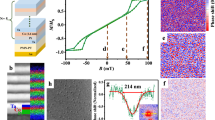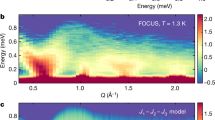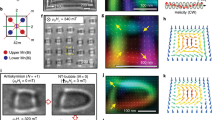Abstract
Mechanical control of magnetism is an important and promising approach in spintronics. To date, strain control has mostly been demonstrated in ferromagnetic structures by exploiting a change in magnetocrystalline anisotropy. It would be desirable to achieve large strain effects on magnetic nanostructures. Here, using in situ Lorentz transmission electron microscopy, we demonstrate that anisotropic strain as small as 0.3% in a chiral magnet of FeGe induces very large deformations in magnetic skyrmions1,2, as well as distortions of the skyrmion crystal lattice on the order of 20%. Skyrmions are stabilized by the Dzyaloshinskii–Moriya interaction3,4, originating from a chiral crystal structure. Our results show that the change in the modulation of the strength of this interaction is amplified by two orders of magnitude with respect to changes in the crystal lattice due to an applied strain. Our findings may provide a mechanism to achieve strain control of topological magnetic structures based on the Dzyaloshinskii–Moriya interaction.
This is a preview of subscription content, access via your institution
Access options
Subscribe to this journal
Receive 12 print issues and online access
$259.00 per year
only $21.58 per issue
Buy this article
- Purchase on Springer Link
- Instant access to full article PDF
Prices may be subject to local taxes which are calculated during checkout



Similar content being viewed by others
References
Bogdanov, A. N. & Yablonskii, D. A. Thermodynamically stable ‘vortices’ in magnetically ordered crystals. The mixed state of magnets. Sov. Phys. JETP 68, 101–103 (1989).
Rössler, U. K., Bogdanov, A. N. & Pfleiderer, C. Spontaneous skyrmion ground states in magnetic metals. Nature 442, 797–801 (2006).
Dzyaloshinsky, I. A thermodynamic theory of ‘weak’ ferromagnetism of antiferromagnetics. J. Phys. Chem. Solids 4, 241–255 (1958).
Moriya, T. Anisotropic superexchange interaction and weak ferromagnetism. Phys. Rev. 120, 91–98 (1960).
Mühlbauer, S. et al. Skyrmion lattice in a chiral magnet. Science 323, 915–919 (2009).
Münzer, W. et al. Skyrmion lattice in the doped semiconductor Fe1−xCoxSi. Phys. Rev. B 81, 041203(R) (2010).
Adams, T. et al. Long-wavelength helimagnetic order and skyrmion lattice phase in Cu2OSeO3 . Phys. Rev. Lett. 108, 237204 (2012).
Moskvin, E. et al. Complex chiral modulations in FeGe close to magnetic ordering. Phys. Rev. Lett. 110, 077207 (2013).
Yu, X. Z. et al. Real-space observation of a two-dimensional skyrmion crystal. Nature 465, 901–904 (2010).
Yu, X. Z. et al. Near room-temperature formation of a skyrmion crystal in thin-films of the helimagnet FeGe. Nature Mater. 10, 106–109 (2011).
Tonomura, A. et al. Real-space observation of skyrmion lattice in helimagnet MnSi thin samples. Nano Lett. 12, 1673–1677 (2012).
Seki, S., Yu, X. Z., Ishiwata, S. & Tokura, Y. Observation of skyrmions in a multiferroic material. Science 336, 198–201 (2012).
Shibata, K. et al. Towards control of the size and helicity of skyrmions in helimagnetic alloys by spin–orbit coupling. Nature Nanotech. 8, 723–728 (2013).
Morikawa, D., Shibata, K., Kanazawa, N., Yu, X. Z. & Tokura, Y. Crystal chirality and skyrmion helicity in MnSi and (Fe, Co)Si as determined by transmission electron microscopy. Phys. Rev. B 88, 024408 (2013).
Nagaosa, N. & Tokura, Y. Topological properties and dynamics of magnetic skyrmions. Nature Nanotech. 8, 899–911 (2013).
Schulz, T. et al. Emergent electrodynamics of skyrmions in a chiral magnet. Nature Phys. 8, 301–304 (2012).
Yu, X. Z. et al. Skyrmion flow near room temperature in an ultralow current density. Nature Commun. 3, 988 (2012).
Iwasaki, J., Mochizuki, M. & Nagaosa, N. Universal current–velocity relation of skyrmion motion in chiral magnets. Nature Commun. 4, 1463 (2013).
Onose, Y., Okamura, Y., Seki, S., Ishiwata, S. & Tokura, Y. Observation of magnetic excitations of skyrmion crystal in a helimagnetic insulator Cu2OSeO3 . Phys. Rev. Lett. 109, 037603 (2012).
Jonietz, F. et al. Spin transfer torques in MnSi at ultralow current densities. Science 330, 1648–1651 (2010).
Mochizuki, M. et al. Thermally driven ratchet motion of a skyrmion microcrystal and topological magnon Hall effect. Nature Mater. 13, 241–246 (2014).
White, J. S. et al. Electric field control of the skyrmion lattice in Cu2OSeO3 . J. Phys. Condens. Matter 24, 432201 (2012).
Fåk, B., Sadykov, R. A., Flouquet, J. & Lapertot, G. Pressure dependence of the magnetic structure of the itinerant electron magnet MnSi. J. Phys. Condens. Matter 17, 1635–1644 (2005).
Ritz, R. et al. Formation of a topological non-Fermi liquid in MnSi. Nature 497, 231–234 (2013).
Ritz, R. et al. Giant generic topological Hall resistivity of MnSi under pressure. Phys. Rev. B 87, 134424 (2013).
Pedrazzini, P. et al. Metallic state in cubic FeGe beyond its quantum phase transition. Phys. Rev. Lett. 98, 047204 (2007).
Koretsune, T., Nagaosa, N. & Arita, R. Control of Dzyaloshinskii–Moriya interaction in Mn1−xFexGe: a first-principles study. Preprint at http://arxiv.org/abs/1503.03777 (2015).
Gayles, J. et al. Dzyaloshinskii–Moriya interaction and Hall effects in the skyrmion phase of Mn1−xFexGe alloys. Preprint at http://arxiv.org/abs/1503.04842 (2015).
Richardson, M. The partial equilibrium diagram of the Fe-Ge system in the range 40–72 at. % Ge, and the crystallisation of some iron germanides by chemical transport reactions. Acta Chem. Scand. 21, 2305–2317 (1967).
Ishizuka, K. & Allman, B. Phase measurement of atomic resolution image using transport of intensity equation. J. Electron Microsc. (Tokyo) 54, 191–197 (2005).
Acknowledgements
The authors thank Y. Okamura, N. Shibata, Y. Ikuhara, T. Matsuda, A. Kikkawa, Y. Nii, D. Morikawa and X.Z. Yu for discussions. This study was supported by a Grant-in-Aid for Scientific Research (grant no. 24224009) from MEXT and by the Funding Program for World-Leading Innovative R&D on Science and Technology (FIRST Program). K.S. was supported by the Japan Society for the Promotion of Science (JSPS) through a Grant-in-Aid for JSPS Fellows (no. 2609358) and the Program for Leading Graduate Schools (MERIT). J.I. was supported by a Grant-in-Aid for JSPS Fellows (no. 2610547).
Author information
Authors and Affiliations
Corresponding authors
Ethics declarations
Competing interests
The authors declare no competing financial interests.
Supplementary information
Supplementary information
Supplementary information (PDF 334 kb)
Rights and permissions
About this article
Cite this article
Shibata, K., Iwasaki, J., Kanazawa, N. et al. Large anisotropic deformation of skyrmions in strained crystal. Nature Nanotech 10, 589–592 (2015). https://doi.org/10.1038/nnano.2015.113
Received:
Accepted:
Published:
Issue Date:
DOI: https://doi.org/10.1038/nnano.2015.113
This article is cited by
-
Discovery of strong bulk Dzyaloshinskii-Moriya interaction in composition-uniform centrosymmetric magnetic single layers
Science China Physics, Mechanics & Astronomy (2024)
-
Stabilization and racetrack application of asymmetric Néel skyrmions in hybrid nanostructures
Scientific Reports (2023)
-
Direct observation of tensile-strain-induced nanoscale magnetic hardening
Nature Communications (2023)
-
Progress on elliptical magnetic skyrmions
Rare Metals (2023)
-
Giant tunable spin Hall angle in sputtered Bi2Se3 controlled by an electric field
Nature Communications (2022)



